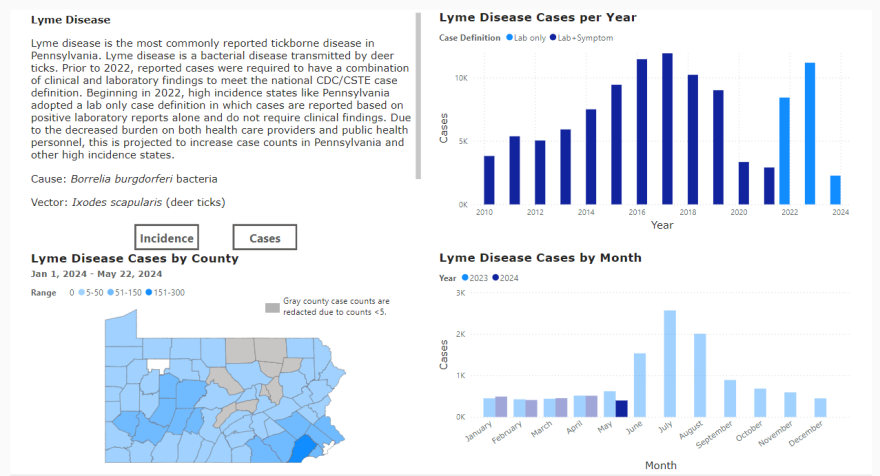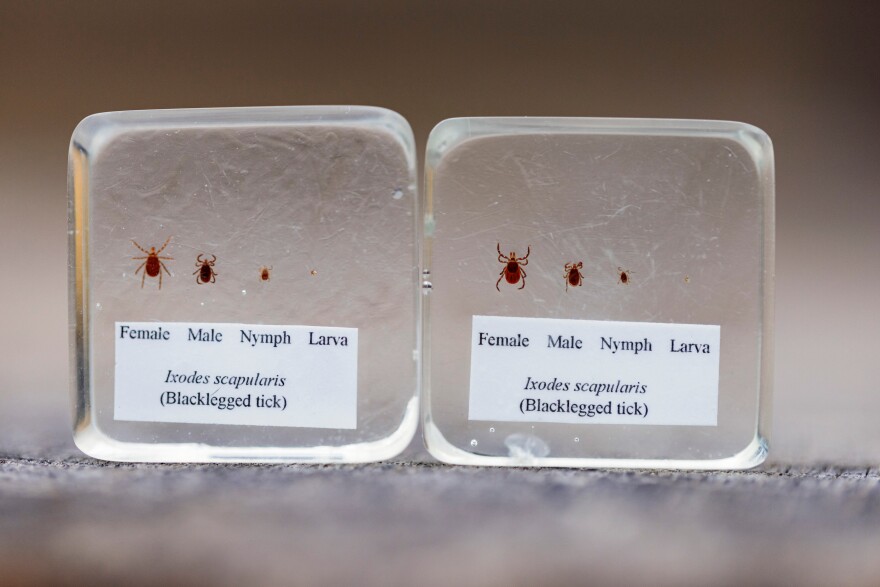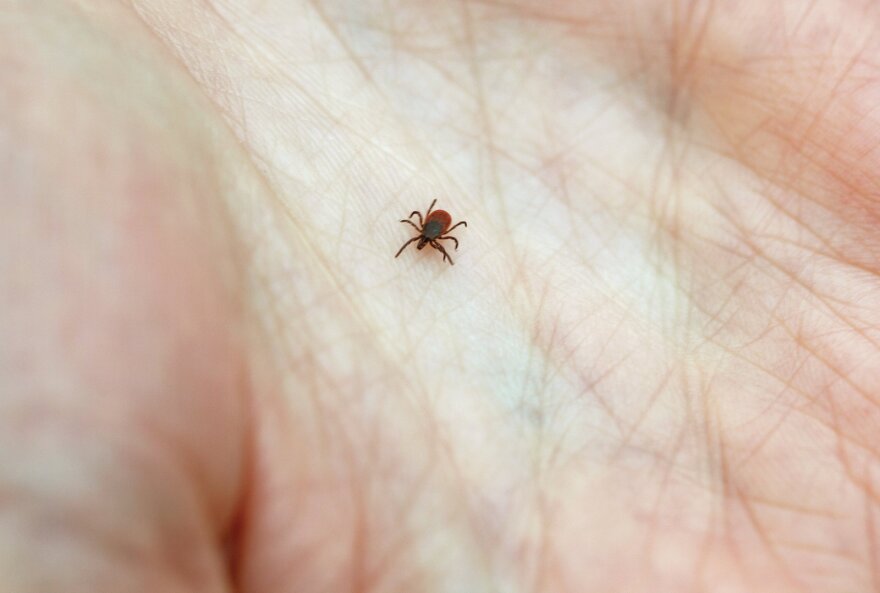BETHLEHEM, Pa. — Ticks are at the most dangerous stage of their life cycle in late spring and early summer, when they’re in the nymphal stage and actively seeking a blood meal, Marten Edwards said.
“Nymphal ticks need to feed on animal blood to make it to the adult stage when they can reproduce,” said Edwards, a Muhlenberg College biology professor. “ … Nymphs are the intermediate stage between larvae and adults. They can transmit the pathogens that cause human diseases, but only if they take their first larval blood meal from an infected animal.
“The nymphs are still very small, so many people are not aware that they have been bitten by a tick. That’s what makes them the most dangerous stage.”
With less than a month until summer begins in the Lehigh Valley, spring is in full swing — and so is tick season.
As residents and tourists explore the region’s many parks, bike trails and scenic overlooks — May is recognized as National Lyme Disease Awareness Month — health and environmental officials are cautioning visitors to check for ticks when their outdoor adventures conclude.
“Pennsylvania has incredible outdoor recreational opportunities, and we want to provide as much information as possible for residents to enjoy them safely,” said Dr. Debra Bogen, the acting secretary of the state Department of Health, in a news release. “Taking appropriate precautions can help avoid Lyme and other tick-borne diseases that can lead to serious illness.
“As a pediatrician, I always recommend doing a tick check after playing outside, especially for children and pets.”
The state DOH earlier this month launched an online dashboard with information about tick-borne diseases, including Lyme disease. The disease, with its characteristic rash, can cause fever, headaches, irregular heartbeats and more.

The commonwealth in 2022 saw 8,413 cases of Lyme disease reported, ranking it ninth in the U.S. for the number of cases reported by population, officials said.
So far, there have been 33 cases of Lyme disease recorded this year in the Lehigh Valley, according to the dashboard, with 17 cases in Lehigh County and 16 in Northampton County.
“My advice is to come up with an easy family tick plan based on your activities and lifestyle. Make it part of your routine — and stick with it every year.”Marten Edwards, Muhlenberg College biology professor
But, there’s no use speculating if this year will be worse or better for ticks than years past — "every year in the Valley is a bad tick year," Marten said.
“Annual fluctuations in the weather can impact when the ticks bite, but the tick populations are influenced by various ecological parameters, and weather is just one of them,” he said. “Our coldest winters are not too cold for them, and when it’s hot and dry — they just go deeper into the leaf litter to chill out.
“My advice is to come up with an easy family tick plan based on your activities and lifestyle. Make it part of your routine — and stick with it every year.”
Here's LehighValleyNews.com’s interview with Edwards. Some answers were edited for style and clarity.
Q: How many tick species are there in our region?
A: Almost all disease transmission is caused by just one species—the blacklegged tick, also known as the deer tick or Ixodes scapularis. Although 24 species of ticks have been found in Pennsylvania, most do not bother humans. American dog ticks are the next most common species of tick in our region, but they do not transmit Lyme disease and rarely transmit any other human diseases.

Q: What does their life cycle look like?
A: Blacklegged ticks have a complicated life cycle that lasts for two years! They have three life stages: larvae, nymphs and adults. The larvae are extremely small and hatch from eggs that are laid by blood-fed female ticks in the summer. The only reason that adult female ticks feed on blood is to produce a batch of up to 5,000 eggs. The tiny larvae rarely bite humans and do not transmit the bacteria that cause Lyme disease. After a larva takes a blood meal, it molts into a nymph.
Adult female ticks can transmit pathogens, but they are large enough that more people will notice that they have been bitten and remove the tick before it can transmit a pathogen, which generally takes more than a day.
Adults are most active and looking for a meal of blood in the late summer into fall and in the spring.
Q: What kind of environment do ticks thrive in?
A: Different species of ticks thrive in different environments. Blacklegged ticks prefer wooded habitats with lots of leaf litter. This can be in a forest, but can be in the backyard – especially if the house is near a wooded area. They spend almost all their lives staying moist and cool below the surface of the leaf layer. They only appear when they are actively looking for a blood meal. They can’t survive very long away from the leaf litter, which is why you generally don’t find them on cut grass, gravel, wood chips or on established trails.
Many people are exposed to these ticks near the home, so it’s important to keep in mind that you don’t need to take a hike in a pristine forest to be exposed to a tick bite. However, if you stick to a paved path in a park with lots of cut grass, your risk will be pretty low.
Q: What are the ticks that are harmful to residents? Why?
A: Here in the Lehigh Valley, we are primarily concerned about blacklegged ticks. They are responsible for almost all disease transmission, especially Lyme disease. The nymphal stage of black legged ticks, which is active in the early summer, is as small as a poppy seed and often goes unnoticed. This is what makes them, by far, the most dangerous tick in our region.
Q: How can residents avoid tick bites?
A: If you spend time outdoors, especially in natural habitats with trees and leaf litter — then have a plan! The plan must be easy and part of your routine — no different from wearing a bike helmet or a seat belt. If you are going for a hike or walking the dog in the woods, then start from the ground up. Ticks don’t leap, fly, or hop off branches — they always crawl up from the ground.
At the minimum, spray shoes and socks with an insect repellent that also works for ticks. Several options are available. If walking in the woods is a frequent activity, consider treating shoes and socks with permethrin — which is very effective and, compared to the risk of tick-borne disease, relatively safe. If you are planning on spending a lot of time in the woods (e.g., nature camp), I suggest having your own pants and shirts commercially treated with permethrin. Commercial clothing treatments last longer than DIY sprays and reduce the risk of over- or undertreating.
Since blacklegged ticks can’t deal with drying out, stay on the trail or path. Good luck explaining that to the dog! Since dogs can get Lyme disease — and finding a tiny nymph on a typically hairy dog is not always a sure bet, make sure you talk to your veterinarian about the several options that are available.
Another easy tip is to do a serious full-body tick check when you return home, keeping in mind that during nymph season, they are easy to miss. For this reason, a shower right after returning home is ideal because it often takes an hour or two for a tick to settle down and start feeding. Ticks can hitch a ride on your pets, clothes, and backpacks. It’s not a bad idea to leave the backpack outside for a while, and throwing the clothes into a dryer for 10 minutes will kill any ticks.
Q: What do I do if I’m bitten by a tick?
A: Don’t panic! The bacteria that cause Lyme disease take more than a day to be transmitted in a tick bite. If you see that the tick just started to bite and you are sure it was not there before, just pull it out and keep it in a plastic bag (I recommend keeping it for a couple of days in the freezer). If there is any chance that the tick has been feeding for more than a day, then remove the tick (and keep it) and get medical attention. Just do it. Don’t wait to feel sick or see some sort of a weird rash.
The bacteria that cause Lyme disease respond well to antibiotics in the early stages of an infection. An unusual rash, headache, or flu-like symptoms should be taken very seriously at this time of the year. Again, the nymphs are tiny and sneaky and their bites are generally painless. In case of any sudden and unexplained illness, make sure you let your medical professional know if there is any chance that you may have been exposed to a tick bite.

Q: How do you remove a tick?
A: The best thing to do is to have a pair of ultrafine-tipped forceps handy in the house or in your car. I have a pair in the backpack I always take on hikes. Grab the tick as close to the skin as possible and pull it straight out. Keep the tick in a sealed plastic bag (I recommend killing it in the freezer) because a medical professional may want to see it to make sure it was a blacklegged tick.
Clean the area with an alcohol pad or equivalent to reduce the possibility of a secondary infection. The internet and other sources of folklore are filled with other tick removal methods, but none of them work better than fine forceps.
Q: Are ticks important to the environment?
A: Ticks are part of the natural environment. They were here long before our forests were cut down for agricultural use and then paved or converted into housing developments. The regeneration of our wildlands is a good thing. We need to remember that when we enter a natural area, we are entering their habitat. It’s “on us” to protect ourselves.
They were here first, and they are here to stay. By taking the precautions mentioned previously — there is absolutely no reason not to enjoy the amazing outdoor recreational opportunities of the Lehigh Valley.
Q: How is your research going?
A: I work with Muhlenberg College students to monitor the diversity and abundance of ticks and the pathogens they transmit each year in the Lehigh Valley region. We look for changes over time, which requires a long-term approach since annual fluctuations are normal and expected.
This will be our 10th year of the study. We are keeping an eye out for new tick species, and we share our results with infectious disease specialists in our area and the Pennsylvania Department of Environmental Protection, which is keeping close tabs on the statewide tick situation.


